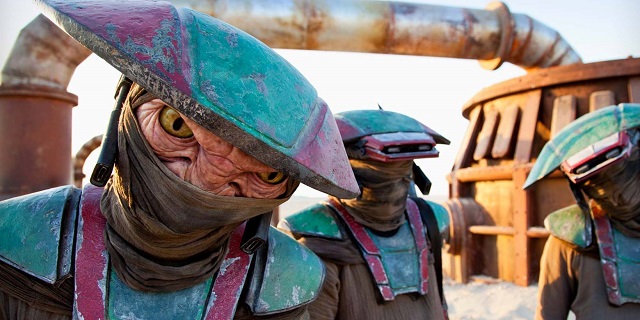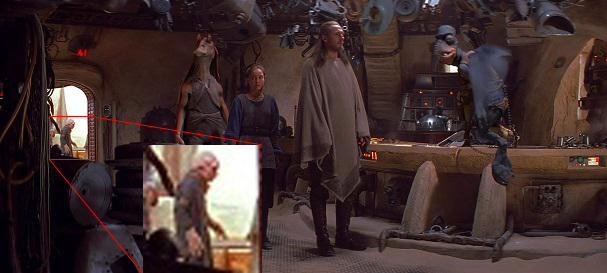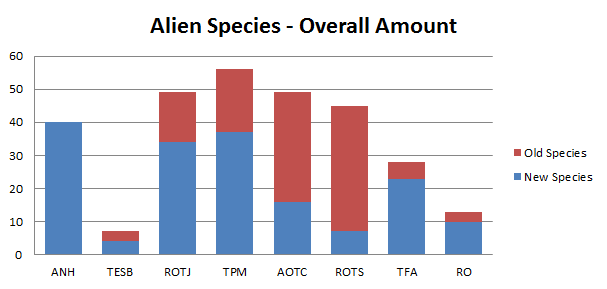
One of the more interesting recurring critiques of The Force Awakens around this time last year was the lack of established alien species. The film’s species diversity was tough to contest in pure numerical terms (I’d have loved to see more aliens in the Resistance, but it was roughly on par with Return of the Jedi in that area—and it certainly turned out to be better than Rogue One), but a notable number of the film’s detractors specifically expressed regret that amidst all the Hassks, Frigosians, and a sudden onslaught of Abednedos, not a single Twi’lek or Gran or Mon Calamari was seen.
What recurring species did appear came in the form of returning established characters like Chewbacca and Ackbar and Nien Nunb, with one hilarious exception: Constable Zuvio, likely by happy coincidence more than the designers’ intent, ultimately turned out to be a Kyuzo, the same species as The Clone Wars‘ bounty hunter Embo. And Zuvio, famously, is barely in the movie at all—about three frames, according to Wookieepedia.
Leaving aside for a moment the question of whether this is a good thing or a bad thing, this has been rolling around in the back of my head all year: just how does TFA really compare to the other films in terms of its alien population? And is Rogue One, for all the emphasis on its contingent of Mon Calamari, really much different? Did the latter film do something right, here, that the former did wrong? Now that we’ve got a pretty solid amount of data on RO, I decided to find out.
Maz Kanata’s castle is undoubtedly TFA’s big alien set piece, the “Mos Eisley cantina moment”—and it has something else in common with the cantina in that it’s the only other scene like that in any of the films that doesn’t include a single previously-established alien species. Even Saw Gerrera’s hideout, the closest parallel in Rogue One, includes a Twi’lek in the form of Beezer Fortuna. The Phantom Menace and Attack of the Clones are packed with these kind of scenes—the podrace, the senate, the Separatist Council, and so on—but I admit that the senate chambers and the Mos Espa Grand Arena felt familiar at the time in a way that TFA didn’t. There were plenty of new species, sure, but plenty of old ones milling about, too. The only films without anything comparable are Revenge of the Sith, with its hyper-focus on Anakin and Obi-Wan, and of course, The Empire Strikes Back, the least diverse Star Wars film by any and every measure.
Did the differences really stand out? Before we look at the numbers, some notes on my data:
- Everything, of course, comes from Wookieepedia. In the case of the first six films, I used both the Legends and canon lists as my starting point and made adjustments only in very special cases.
- Some species are only named in Legends, at least as far as the wook has noticed, but as long as it’s clear that there’s a distinct alien standing there, the exact details weren’t really important—thus, they still counted toward the total.
- On the other hand, there were a few characters who appeared outwardly human but had been established as aliens by the Expanded Universe—a Balosar among Lando’s guards, for example, and more famously, Depa Billaba being a member of the Chalactan species rather than a human from the planet Chalacta. In these cases, in the absence of a clear canonization of the Legends detail, the characters were counted as human (sorry, Dannik Jerriko).
Lastly: while this was a breeze compared to my broader diversity scoring projects, it proved to be more of a challenge than I expected—Star Wars is nothing if not complex. Did you know that there’s a Sullustan in The Phantom Menace?

Wookieepedia seems to think that’s a Sullustan. I was unconvinced at first, but after digging around a little I landed on this piece from just a few months ago on StarWars.com that confirms there’s one on the ship Anakin and Padmé take to Naboo in Attack of the Clones. Star Wars is big on reusing old costumes they’ve got lying around—just look at how many cantina aliens appear in Jabba’s palace—so once I had confirmation of a Sullustan somewhere in the prequels, seeing one in Mos Espa didn’t seem so implausible, so I decided to count it. This is a good example of the kind of calls I occasionally had to make while going through the data, so as always, I make no claims of absolute certainly.

Sure enough, Empire is the black sheep of the bunch, featuring only seven alien species in total. While Rogue One‘s numbers could change a bit once the film hits blu-ray, this seems about right—thirteen species to Empire‘s seven, which is still less than half of TFA’s twenty-eight. Return of the Jedi looks more like a prequel film than an original trilogy film, and most interesting of all is the trend, where the overall number of species per film has been steadily declining ever since its peak in TPM, which featured not only the highest total number but also debuted the most new species since A New Hope. There’s a notable trend between old and new species in there as well, but to get a better sense of that, let’s look at the proportions.

Suddenly Empire doesn’t stand out quite as much, does it? In terms of the percentage of new species, Jedi actually narrowly beats TPM 69-66, and what’s really interesting is the downward trend starting with Jedi and continuing all the way to RotS, which had a series low of 16% new species—seven out of forty-four. What seems to be happening here is a big explosion of worldbuilding that begins in Jedi (when the OT finally pays off its Jabba plot bunny and really dives into the galactic underworld) and continues into TPM, which had an entire Galactic Republic to establish almost from scratch, then as the prequel trilogy comes to focus more and more on its handful of main human characters (and Lucasfilm assembles a bigger and bigger catalog of species designs and costumes), the worldbuilding—at least in terms of species—grinds almost to a halt. Aliens cease to be set pieces and instead become scenery.
Whether this is a problem in and of itself is very debatable, but look at that downward trend and then compare it to TFA and Rogue One, both of which feature a higher percentage of new species than any film since ANH. Looking at that graph, one can certainly understand why TFA felt so different: not only did it objectively introduce a huge amount of new aliens, but up until that point we’d been slowly trained to expect less and less of them. [1]Note, incidentally, that Rogue One‘s percentage isn’t much different from TFA’s—and even in raw numbers, it featured ten new species, which is almost as many as Empire and … Continue reading
So that brings us back to the original question: did The Force Awakens utilize too few existing aliens? I really don’t think so. What the numbers suggest is that the overall volume of species both new and old was about average, but it felt like a huge difference because the prequels had slowly, almost unnoticeably, stopped doing that kind of thing in favor of cramming their big scenes full of Weequays and Quarren and Ishi Tib. If Revenge of the Sith’s demographics feel more like “your” Star Wars, that’s just a matter of taste, I guess—but in terms of creativity, TFA is very much of a piece with Jedi and TPM.
Update: the original version of this article failed to account for one new species in Revenge of the Sith: Polis Massans. That brings its new percentage to 16%; better, but still the lowest of any film.
| ↑1 | Note, incidentally, that Rogue One‘s percentage isn’t much different from TFA’s—and even in raw numbers, it featured ten new species, which is almost as many as Empire and RotS put together. |
|---|

Now that´s interesting… my only complaint TFA-wise is that most every other story created in the time frame or as a companion piece (Journey to TFA) had to have an abednedo crammed in it. Suddenly there were abednedos everywhere!
And question, which are the new species ROTS introduced? I can just think of Pa’uans.
Kaleesh, Mustafarians, Pantorans, Pau’ans, Utai, and Zeuols.
44 total species is a solid number, but by that point they had accumulated so many prequel-era designs they just don’t seem to have felt compelled to stick anything new in the background just because.
Hm, I’m glad you asked—while I was replying it hit me that I missed Polis Massans. So that’s seven new species actually—I updated the piece accordingly.
Part of the aim and thrill of the original Star Wars to give that sense of wonder – of seeing new and strange aliens. That’s even part of the ethos 60s Star Trek – to seek out new life forms. So I think it would make sense to have that strong sense of new aliens in TFA – it’s hearkening back to that vibe.
Conversely, in RO the point is to fill in the blanks of an established world — the “newness” is secondary. However, I think their might be more species than you list — think of the scenes of Kefrey and Jedha city — there are lots of various pilgrims and aliens and the like… it’s just that they are background. Of course, that’s what the Cantinas are… just background, but they get focused on instead of quickly slid past (or covered up in robes… lots and lots of robes).
It might be interesting to see how much screen time aliens get — are they just there, or do they have importance? There might not be many aliens in Empire – but Yoda might have more dialog than the rest of the aliens in the OT combined. Which is the better angle of diversity — a bunch but in the background, or fewer but up front and center in a major role?
That’s been a perennial question, actually—what’s better, one Jyn Erso or five Toryn Farrs? The answer, of course, is both.
This is pretty interesting stuff, indeed. I understand some people thought it was odd not to see a bunch of familiar aliens in TFA, but could you imagine the extra firepower that would have given those that see Episode VII as a simple rehash of A New Hope?
The simple answer, to me, is the story visits many new worlds in TFA, so why not include mostly new aliens? Seems logical in my head, and the same could be said for Rogue One (though I do wish one of the main crew had been an alien, but that’s coming from a huge fan of aliens in Star Wars).
I’m really curious to see what they do with the Han Solo movie as far as aliens go; I feel like it’s a good canvas to have a 50/50 split of old and new, as well as to allow more aliens to have bigger, more interesting roles.